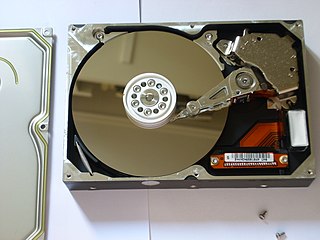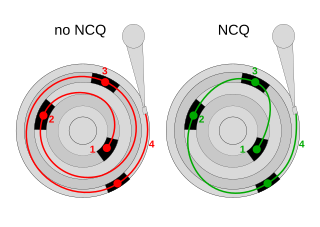
Disk storage is a general category of storage mechanisms where data is recorded by various electronic, magnetic, optical, or mechanical changes to a surface layer of one or more rotating disks. A disk drive is a device implementing such a storage mechanism. Notable types are today's hard disk drives (HDD) containing one or more non-removable rigid platters, the floppy disk drive (FDD) and its removable floppy disk, and various optical disc drives (ODD) and associated optical disc media.

In computing and in systems theory, first in, first out, acronymized as FIFO, is a method for organizing the manipulation of a data structure where the oldest (first) entry, or "head" of the queue, is processed first.

A hard disk drive (HDD), hard disk, hard drive, or fixed disk, is an electro-mechanical data storage device that stores and retrieves digital data using magnetic storage with one or more rigid rapidly rotating platters coated with magnetic material. The platters are paired with magnetic heads, usually arranged on a moving actuator arm, which read and write data to the platter surfaces. Data is accessed in a random-access manner, meaning that individual blocks of data can be stored and retrieved in any order. HDDs are a type of non-volatile storage, retaining stored data when powered off. Modern HDDs are typically in the form of a small rectangular box.

[[Image:Innansicht Festplatte 512 MB von Quantum.jpg|thumb|Inside view of a hard disk]]

The ST-506 and ST-412 were early hard disk drive products introduced by Seagate in 1980 and 1981 respectively, that later became construed as hard disk drive interfaces: the ST-506 disk interface and the ST-412 disk interface. Compared to the ST-506 precursor, the ST-412 implemented a refinement to the seek speed, and increased the drive capacity from 5 MB to 10 MB, but was otherwise highly similar.

In the maintenance of file systems, defragmentation is a process that reduces the degree of fragmentation. It does this by physically organizing the contents of the mass storage device used to store files into the smallest number of contiguous regions. It also attempts to create larger regions of free space using compaction to impede the return of fragmentation. Some defragmentation utilities try to keep smaller files within a single directory together, as they are often accessed in sequence.

Magnetic storage or magnetic recording is the storage of data on a magnetized medium. Magnetic storage uses different patterns of magnetisation in a magnetizable material to store data and is a form of non-volatile memory. The information is accessed using one or more read/write heads.

In computing, Native Command Queuing (NCQ) is an extension of the Serial ATA protocol allowing hard disk drives to internally optimize the order in which received read and write commands are executed. This can reduce the amount of unnecessary drive head movement, resulting in increased performance for workloads where multiple simultaneous read/write requests are outstanding, most often occurring in server-type applications.
Shortest seek first is a secondary storage scheduling algorithm to determine the motion of the disk read-and-write head in servicing read and write requests.
The elevator algorithm, or SCAN, is a disk-scheduling algorithm to determine the motion of the disk's arm and head in servicing read and write requests.

Cylinder-head-sector (CHS) is an early method for giving addresses to each physical block of data on a hard disk drive.
Tagged Command Queuing (TCQ) is a technology built into certain ATA and SCSI hard drives. It allows the operating system to send multiple read and write requests to a hard drive. ATA TCQ is not identical in function to the more efficient Native Command Queuing (NCQ) used by SATA drives. SCSI TCQ does not suffer from the same limitations as ATA TCQ.
FSCAN is a disk scheduling algorithm to determine the motion of the disk's arm and head in servicing read and write requests. It uses two sub-queues. During the scan, all of the requests are in the first queue and all new requests are put into the second queue. Thus, service of new requests is deferred until all of the old requests have been processed. When the scan ends, the arm is taken to the first queue entries and is started all over again.
N-Step-SCAN is a disk scheduling algorithm to determine the motion of the disk's arm and head in servicing read and write requests. It segments the request queue into subqueues of length N. Breaking the queue into segments of N requests makes service guarantees possible. Subsequent requests entering the request queue will not get pushed into N sized subqueues which are already full by the elevator algorithm. As such, starvation is eliminated and guarantees of service within N requests is possible.

In computer storage, disk buffer is the embedded memory in a hard disk drive (HDD) or solid state drive (SSD) acting as a buffer between the rest of the computer and the physical hard disk platter or flash memory that is used for storage. Modern hard disk drives come with 8 to 256 MiB of such memory, and solid-state drives come with up to 4 GB of cache memory.

Input/output (I/O) scheduling is the method that computer operating systems use to decide in which order I/O operations will be submitted to storage volumes. I/O scheduling is sometimes called disk scheduling.
The deadline scheduler is an I/O scheduler for the Linux kernel which was written in 2002 by Jens Axboe.
vRPM, or virtual Revolutions Per Minute, was a term for a synthetic measurement of performance introduced by SanDisk for solid state drive (SSD) storage devices inside client PCs. vRPM was created to give users a metric to compare SSD performance to the hard disk drive (HDD) and other SSDs.
Higher performance in hard disk drives comes from devices which have better performance characteristics. These performance characteristics can be grouped into two categories: access time and data transfer time .
External memory graph traversal is a type of graph traversal optimized for accessing externally stored memory.










